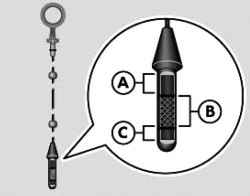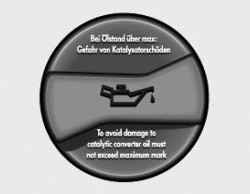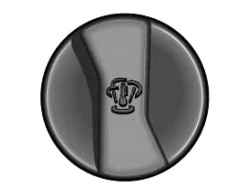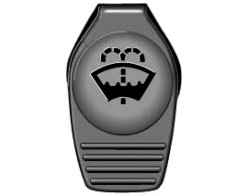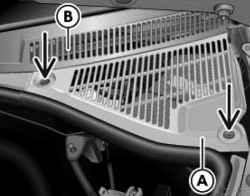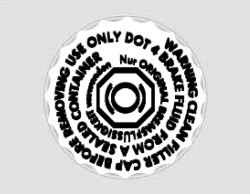 printable version printable version
The work in the engine compartment
Checking the oil level Place the vehicle on a horizontal surface. Stop the engine and wait a few minutes until the oil will merge into the tray. Open the hood Remove the dipstick. Wipe dipstick clean wipes and put it back until it stops. Remove the dipstick again and read the oil level. Again push the dipstick all the way.
If the oil is in the area A (Fig. 1.126) oil should not be topped. If the oil is stored in the area B can pour oil (approximately 0.5 L). If the oil is in zone C, oil must be topped up (approximately 1.0 L). Oil consumption is normal. Flow rate can be up to one liter per 1000 kilometers. Therefore, the oil level should be checked regularly - preferably every refueling and before long journeys. In special conditions, for example, during prolonged high-speed traffic in summer, when towing a trailer or when driving in the mountains, try to maintain the oil level in the area A but not higher.
Topping up the engine oil
Add oil in small portions. Occasionally stop pouring oil, wait for a while and check the oil level in order not to pour too much. Only the oil level will be in zone A carefully screw the lid.
Coolant The engine cooling system must be filled in a mixture of water and low temperature concentrate our G12 or concentrate with the specification TL-VW 774 F (purple).
NOTE The coolant is a mixture of water and concentrate low temperature (not less than 40%). |
This mixture not only allows the vehicle to operate the temperature -25 ?° C, but also protects parts of the cooling system from corrosion. Furthermore, this prevents the formation of a mixture of lime and has a high boiling point. Concentrate Ratio of low temperature must always be at least 40%, also in the summer season. At particularly low temperatures can increase the share of low temperature concentrate G12. The proportion of concentrate should not be more than 60%, otherwise the mixture becomes less hardy. Furthermore, deteriorating engine cooling. A mixture of 60% of the concentrate, helps the vehicle to a temperature of about -40 ?° C.
ATTENTION Other additives may cause low temperature corrosion of parts of the cooling system. Further possible failure of the engine cooling system, and as a consequence, a significant engine failure. |
You can mix the low temperature concentrate G12 (purple) concentrates G12 (red) or the G11. You can recognize the structure G12 on purple coolant expansion tank. If the coolant in the expansion tank brown mean structure G12 is mixed with another low temperature concentrate. In this case, be sure to replace the coolant. Otherwise you may cause serious disturbances in the operation of the engine until it breaks.
Checking and topping up the coolant Turn off the engine and let it cool.
To protect against burns, place a large piece of solid matter in the tank stopper (Fig. 1.128) and carefully unscrew the cap. Check the coolant level in the expansion tank. If the level is below the mark ?«MIN?», add coolant. Top up only with new coolant. Do not top up the fluid above $ ?«MAX?». Firmly tighten the plug.
Windshield washer fluid and wiper blades
| Fig. 1.129. In the engine compartment: Cover fluid reservoir for windshield washer
|
By wipers and headlamp washer fluid flows from the reservoir in the engine compartment. One of clean water is insufficient for high-quality glass cleaner. Should always be added to the water means the original VW G 052 164. This means not only cleans the glass, but also prevents it from icing, so it should be mixed into all year round. Follow the directions on the package.
Replacing the wiper blades Before replacing the brushes turn off the windshield wipers.
NOTE Regularly check the condition of the wiper blades and replace if necessary. |
Pull the wiper arm away from the glass. It does not hold the brush. Turn the brush counterclockwise fully to the left and remove it. Slide the new wiper blade of the same length and execution on a leash leash and turn clockwise to the right. Put a leash on the spot. If the brush smear dirt on the glass, in the presence of damages replace them, and dirty brushes clean. If this does not help, you may need to adjust the angle of leads - refer to the workshop for checking and adjusting the angle of leashes.
Check brake fluid level
Turn both constipation (Fig. 1.130), such as a coin, 90 ?° and remove the front cover A. Determine the level of brake fluid in a transparent tank. The fluid level should be between the ?«MIN?» and ?«MAX?». Then slide the cover in the guide and retighten both the latch holder to fix them.
During operation of the vehicle brake fluid level decreases gradually as the brake pads wear and automatic podregulirovaniya their position. If the brake fluid level has dropped significantly in a short time and became below ?«MIN?», it can be assumed that the braking system is leaking. When the brake fluid level is too low, this is signaled by a warning message ?«STOP BREMSFLUSSIGKEIT ANHALTEN!?» (?«Brake fluid. STOP!") On the display of the instrument panel and burning brake warning light. In this case, you should immediately seek service enterprise a Volkswagen or any other workshop to check the brake system.
Change brake fluid Brake fluid is hygroscopic. It absorbs moisture from ambient air. Over time the water in the brake fluid causes corrosion of the braking system. In addition, the boiling point of brake fluid is greatly reduced that under severe braking causes the formation of vapor bubbles in the brake system, which reduces braking efficiency. Brake fluid should be changed at least every two years. Use only the original brake fluid. Specification liquid US-Norm FMVSS 116 DOT 4.
| 




